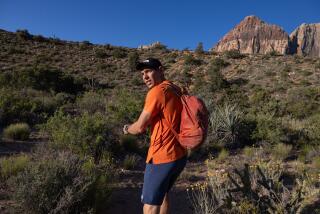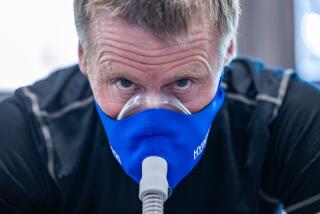Yosemite’s Maitre d’ of Ski Just Won’t Quit
- Share via
YOSEMITE NATIONAL PARK, Calif. — Each morning, as the Sierra Nevada winter gives way to snow-bright spring, a couple of hundred would-be skiers gather in front of the Badger Pass Lodge, waiting for Nic Fiore to ring the ski school bell.
Fiore, 67, is the maitre d’ of ski at Badger Pass, the oldest ski resort in California. As tough and wiry now as when he first came here to teach skiing in 1948, his ebullient, “Good morning! How are you?” has greeted neophytes to the Yosemite Ski School for 40 years.
By his estimate, Fiore has taught 35,000 to 40,000 people to ski. His employers at the Yosemite Park & Curry Co. say that number is way low and double the estimate to “at least 80,000.”
Fiore, who stands 5 feet 6 and weighs 140 pounds, frequently finds himself teaching the children and grandchildren of former students. “Nic is the magnet that draws people back generation after generation,” said Yosemite Park Superintendent Jack Morehead.
“I came here from the Laurentian Mountains (in eastern Canada) to teach one season,” Fiore said. A French Canadian from Montreal, he was used to skiing big mountains but was unprepared for his first look at Yosemite.
Recalling how he drove into Yosemite Valley during a heavy snowstorm, Fiore said he looked up at the steep cliffs towering 3,000 feet above the car, thinking “My God, how am I going to teach beginners to ski down that! “
The next day he learned that the Badger Pass ski area was high atop those cliffs, tucked away in a gentle, timbered bowl on the road to Glacier Point. The ski runs were short and not steep enough to offer the young ski teacher any challenge.
Wanted a Bigger Mountain
“After skiing here two days I was not even certain I wanted to stay the winter,” Fiore said. “I thought I would be happier on a bigger mountain.”
The doubt lingered only a short time. “Deep down, Yosemite made such an impact on me,” Fiore said. “I fell in love with the place.”
Teaching skiing in the winter, working summers in the park’s hotels and managing the five High Sierra Camps that dot the wilderness back country, Fiore stayed on. A physical fitness buff, he spends his off hours jogging the high country trails or bicycling along the park’s highways.
On a recent morning, as the last sounds of the bell tolled across the snowy slopes, Fiore--outfitted in expensive ski togs and jaunty cap--snapped into his skis and began sorting through the gathered men, women and children. He personally directed them toward signs stuck in the snow designating various levels of skill.
Eyeing adults who were awkwardly trying to walk on rented skis, he pointed to the beginner’s classes and then, moving among anxious parents leading their youngsters, he asked each a question or two and directed the children to one of the waiting ski teachers. A dissatisfied father insisted that his son should be in a more advanced class. “Trust me,” Fiore said, smiling his biggest smile, reassuring the man that the boy would do just fine where he was assigned.
Within half an hour, Fiore sorted out the chaos of the morning session, assigning eight to 10 pupils to each of a dozen ski instructors and sending them on their way. This late in the season Fiore has cut back on his staff, but at the height of the season, he employs up to 35 teachers and keeps them working long hours.
Badger Pass, located in the Sierra Nevada east of Fresno, was developed by Curry Co. in 1935. At the time its lumbering “up-ski” sled and two rope tows were state-of-the art lifts. Over the years, this small area has been dwarfed by bigger resorts like Mammoth Mountain. Now its short runs and gentle slopes are considered a “family area.” On big days 2,000 skiers from Los Angeles, Fresno, San Francisco and elsewhere ride the four chair lifts and one T-bar. Nearly half of them enroll in the ski school.
Starts With Scheduling
Fiore’s day starts at a small desk in a tiny room in the bottom of the lodge, where he works out the morning and afternoon schedules. This 15-by-30-foot basement cubbyhole has been the ski instructors’ dressing room for as long as Fiore has worked here. Crowded around him are lockers, steam pipes and ski equipment.
“Welcome to my office,” he grinned, and then introduced several of the instructors who were pulling on boots, getting ready for the day. Colin Baldock, a young Australian who has also taught in Switzerland and Austria, waited until Fiore was out of earshot, then said, “I’ve learned more about teaching here than anywhere else in the world.”
Active in professional ski instructors’ associations, Fiore has spent much of his career developing and unifying techniques for teaching skiing. “When I started teaching at St. Adelle (in the Laurentians), every school had its own method,” Fiore said. There he met Luggi Foger, an early advocate of a unified method called the Arlberg technique.
Different Conditions
When Foger took over the Yosemite Ski School, he recruited the French-speaking Fiore. “I spoke very little English and wasn’t at all prepared for the Sierra snow. . . . The winters here are milder and the snow is wet and heavy, what we call Sierra cement,” Fiore said. “The first time I tried to ski it, I got tripped up and did somersaults . . . falling head over heels down Rail Creek (Badger’s longest ski run),” he said, laughing at the memory.
As an instructor, Fiore started teaching the beginner classes and worked his way up. By the time he was made ski school director in 1956 he was married and raising a family in Yosemite Valley.
Each spring, when the snow melts, he heads for the high country and the five mini-resorts located at strategic intervals along the wilderness trails. Supplied by mule trains, each of these camps has scores of tent cabins for visitors, a central kitchen and dining hall, showers and a small store. They are staffed by 45 employees recruited and trained by Fiore.
Based in Tuolumne Meadows, Fiore hikes from one camp to another, making sure everything is in working order. When he’s not in the back country, he spends as much time as he can bicycling over the Sierra highways. In the off season he and several friends go bicycle touring along the coast or through the wine country.
When will he retire? “Oh, maybe when I’m 70, I’ll see how I feel,” Fiore said, his face wrinkled in a big grin. “Right now I feel fantastic.”
More to Read
Sign up for The Wild
We’ll help you find the best places to hike, bike and run, as well as the perfect silent spots for meditation and yoga.
You may occasionally receive promotional content from the Los Angeles Times.






